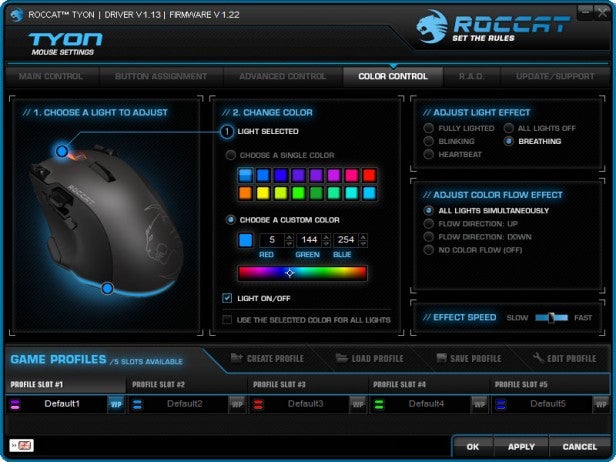

I found its ideal range to be a little finicky: You want to be especially careful to make sure that the mic is pointed at your face to make sure you’re coming in at full volume. The plastic-coated wire is longer than average, making it very adjustable. Lastly, let’s take a look at the headset’s detachable unidirectional wired boom mic. That’s still very good, though: Most wireless gear tends to drain significantly faster with RGB lighting turned on, so keeping this close to the projected output is impressive. In my testing, I’ve found the headset tends to last 2-3 days per charge with the RGBs on, which comes just short of that – closer to 20 hours. According to Roccat, the headset should last for up to 24 hours on a single charge. The other side of the wireless coin, battery life, is one of Elo 7.1 Air’s strongest features. That’s in line with the Elo 7.1 Air’s branding, but it seems odd to me: Many headsets with this kind of connection go the extra mile to enable as much cross-compatibility as possible.

It doesn’t work with the PlayStation 5, and only provides simple stereo sound for a docked Nintendo Switch. The odd part, to me at least, is that the headset is effectively PC-exclusive. That said, I noticed that it takes a good 10 seconds or so to connect to the dongle when you turn it on, which doesn’t seem like a long time until you’re waiting for your game audio to kick in. It connects exclusively through a 2.4GHz wireless connection via a USB dongle, which delivers a stable, lag-free connection, all of which is perfectly normal. The charging cable does not double as a wired audio connection.Ĭonnectivity is something of a curiosity on the 7.1 Air. Lastly, there’s a USB-C port for charging and facilitating firmware updates. In theory, I assume the hard-to-press design is meant to prevent unintentional shutoffs, but I think they went a little too far. Curiously, the mute button is a large oval and very easy to press, but the power button just below is small and inset, so it’s annoying to find and more annoying to use.
#ROCCAT BROWSER REVIEW PC#
From top to bottom, you have two volume rollers – first for PC volume, then for mic monitoring volume. The Elo 7.1 Air has a fair number of onboard controls, which are all loaded onto the back of the left earcup. Both RGB elements are adjustable through Swarm, Roccat’s configuration software. The backs of the cups both have fairly large RGB-enabled logos: On the left side, you have the Roccat snow leopard. The padding, leatherette-covered memory foam, is fairly firm, though not uncomfortably so.
#ROCCAT BROWSER REVIEW DRIVERS#
The earcups are nice and roomy, giving plenty of space for the speakers’ 50mm Neodymium drivers to do their thing. Having used quite a few of them recently, though, it’s hard to deny that they do a good job making a gaming headset feel more comfortable, especially over a long period of time. As I’ve written in previous reviews, I’m not wild about the aesthetics of the self-adjusting top band – they often don't sit flush on my head, which looks weird. Weighing in at 12.38 ounces (.77 pounds), it feels surprisingly light on-head thanks to the top-band, which distributes the weight across the top of your head. It’s well-constructed, but it also doesn’t look “nice,” either. The studio-style self-adjusting top band has mesh-coated foam padding, but has leatherette on top. You can see it in the headset’s materials and construction: The cups and rotating forks are made from a durable, dark gray plastic, brought together with a two-piece adjustable metal band.

The Roccat Elo 7.1 Air straddles the line between premium and budget gaming headsets. 17 Images Roccat Elo 7.1 Air – Design & Features


 0 kommentar(er)
0 kommentar(er)
